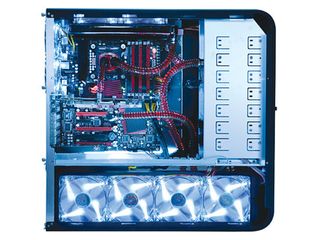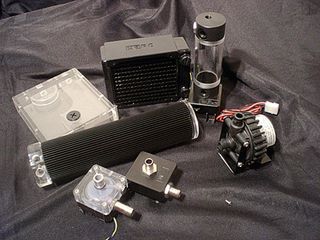PC water cooling guide: all you need to know
Keeping your PC cool and quiet is now cheaper and easier

Remember the heady days of the Pentium 4, when a single CPU could generate enough heat to keep you warm through winter?
They were great for cutting down on household utility bills, but as soon as the weather started to improve, systems would fall over as the mercury rose.
They were also slow, and their performance aged quickly. As a result, many of us looked to watercooling to bring down core temperatures. This in turn reduced noise and increased the useful lifespan of our components by just a few months through overclocking.
To meet demand, early online component stores were stocked full of arcane heatsinks, boasting hand-milled plates and liquid cooling that looked like something ripped off the back of a refrigerator. The weirder, the better.
A quick flick through the catalogue of any online retailer now, though, suggests that the golden age of cooling is over. It's almost impossible to find a TEC-based chiller, and there's clearly no demand for funky accoutrements, such as UV lighting and external tanks.
It's not surprising. The most recent, fastest quad-core processors won't even make an Eskimo sweat. This is due to the move to ever-more ludicrous efficiency and 32nm manufacturing techniques. Air coolers are far more effective and quieter than they ever used to be, and overclocking is hardly a necessity when a three-year-old CPU can cope with the latest games.
Or so received wisdom goes.
Get daily insight, inspiration and deals in your inbox
Get the hottest deals available in your inbox plus news, reviews, opinion, analysis and more from the TechRadar team.
The joy of watercooling has never been about its practical value. It's about taking a PC system and personalising it in ways that lesser mortals can't even imagine. It's about mixing electronics and liquids with panache and bravado and creating something that isn't a slowly sparking mess.
It's also - as it always has been - about beating The Man. Sure, you can buy a shiny new four or six core processor for £150 and get top performance with just a bit of heat paste, but where's the satisfaction in that? How much more impressive is it to hit the same benchmark score for half the price?
It's possible, and we're going to show you how to do it.

One of the historical drawbacks of watercooling is that it's tended to be quite expensive. Saving £70 on a CPU by spending £300 on a radiator and pump might earn you a certain caché in some circles, but it won't earn you the Nobel Prize for Economics.
To make matters worse, while watercooling was essential for overclocking, many people dabbled in it to silence noisy PCs for media centre work. Unfortunately, many self-built systems tended to be as loud, if not louder, than a decent fan.
Cool trends
If you've been watching closely, though, you might have noticed one of the more intriguing trends in component sales that's been going on recently. There's been a dramatic drop in the cost of self-contained CPU water cooling kits. These units are relatively new, and are designed to make watercooling simple, cheap and risk-free.

If you've not seen one before, these boxey devices combine everything you need for watercooling in a single unit. The bulky part will contain a pump, reservoir, radiator and a fan which bolts onto the rear exhaust ports of your case. The other end is attached to a CPU block. Everything is filled with fluid and sealed in the factory, so you don't need to risk getting your PC wet or worry about checking the levels and refilling at a later date.
Pioneered by Canadian outfit CoolIT Systems, the first self-contained coolers appeared four years ago based on designs used in server farms. These original models came with a clever control panel, but overall it had two significant flaws: it was expensive and arguably less effective than a run of the mill £20 air cooler at keeping temperatures down.
That was then, however. Now, several new revisions have vastly improved on the original design, which has been further pushed on by competition from the likes of Asetek. Modern all-in-ones are everything they promised they'd be.
Starting at around the same price as a high-end heatsink of the traditional variety, the self-contained watercoolers of today are whisper quiet and can chill a chip at one thousand paces. Cooler Master has even gone one further, building a self-contained Peltier-powered CPU cooler, the V10.

CoolIT, meanwhile, has just gone into partnership with Corsair to increase the market for its all-in-ones, and the first product of the union is the H60.
Staying breezy
While the watercooling purist may look upon these all-in-ones with scorn, they do work and, cost-wise, are a bargain. There's only a £10 difference between a midrange air cooler and the H60, for example, and you'll not only get better performance from the latter it looks a lot better too.
As far as designing a complete system goes, though, the only thing you need to consider is that the unit which replaces a rear case fan does contain the radiator from the CPU, which is cooled by drawing air across it towards the vent.
So if you have a lot of other hot components, you'll need to make sure they aren't heating up the inside of your case to the point of rendering the CPU cooler useless. In other words, remember that just because you have one of these, don't think you can skimp on fans elsewhere.
When it all goes Pete Tong
So you've sprung a leak, and your PC has begun gently sparking away to itself. That's not good is it?
First things first, don't panic. Although water and electricity aren't known as the best of bedfellows, the damage is probably not as bad as you think.
The first thing you should do is pull the plug. Hit the main trip switch on your fuse box. Even turning a PSU off using the power switch around the back may not stop it drawing current, so removing the cable is the only safe option. Pull the ATX connector from the motherboard too, just to be sure.
Your next job is to dry everything thoroughly. Mop up any obvious spillages with an old cloth, and then leave your machine in a warm place. Ideally, you should take components such as the motherboard out and dry them separately, but 24 hours next to a radiator should do the job. With a bit of luck, that should be all you need to do, and your PC will work when you boot up, but do remember two things.
First, the obvious: fix the leak and make sure the cooling system is working properly before you plug everything back in. Second, remember that the power supply is where the big voltages are, and that underneath the cover there are a lot of capacitors, which store up electricity for various reasons.
If the PSU is wet, then, take extra care. In the old days, when PSUs were sited at the top of the case, this wasn't so much of a problem. New cases, though, tend to put the power supply at the bottom, exactly where water will gather.
How easy is water cooling?
Fitting a self-contained watercooler is only marginally more complicated than attaching a standard heatsink. The main complication is that the CPU block is always attached to the radiator and fan assembly, so manoeuvring the two into position can be quite a tricky process.
A PC case with access to the back of the motherboard is essential, but even then it's easy to pull a bit too hard and unhook a pipe - which means writing the whole kit off.
Building your own system isn't hard, per se, but you do need a lot of patience to assemble carefully, tie up pipes safely and check all the seals as you go. The biggest danger to any watercooling set-up is rushing it and botching the job.

A minor point before we begin, but the term watercooling is a slight misnomer. The fluid that's pumped around a liquid chilled PC is rarely just a couple of Hs with a bit of O. Usually it's mixed with some sort of additive in order to improve efficiency and prevent limescale build up or corrosion of the plastic parts inside your system.
You could use distilled water - if you were sure that there's absolutely no mineral content that might get left behind in the radiator - but it's really not worth the long term risk. Especially when coolants come in a range of funky colours.
That minor quibble aside, all water systems are based around a similar set of components - a pump, reservoir, heat transfer block, piping, a radiator and fan. They vary in size from giant external towers like the Zalman Reserator V2 series to compact all-in-ones like the CoolIT Eco ALC, but the general principle is always the same.

Most Popular

